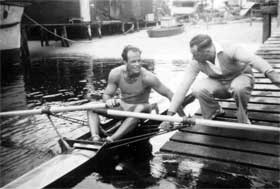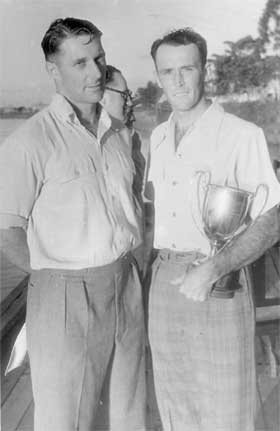World Professional Sculling Championships
- Introduction
- Record of Racing—table summarising racing results from 1831 to 1958
- Brief History of Australians in World Professional Sculling
- 1926 Rules Governing World Professional Sculling
- 1863 Chambers (GBR)
def Green (AUS) - 1876 Trickett (AUS)
def Sadler (GBR) - 1877 Trickett (AUS)
def Rush (AUS) - 1879 Trickett (AUS)
def Laycock (AUS) - 1880 Hanlan (CAN)
def Trickett (AUS) - 1881 Hanlan (CAN)
def Laycock (AUS) - 1882 Hanlan (CAN)
def Trickett (AUS) - 1884 Hanlan (CAN)
def Laycock (AUS) - 1884 Beach (AUS)
def Hanlan (CAN) - 1885 Beach (AUS)
def Hanlan (CAN) - 1886 Beach (AUS)
def Ross (UK) - 1887 Beach retires & forfeits to Kemp (AUS)
- 1888 Kemp (AUS)
def Hanlan (CAN)—twice - 1888 Searle (AUS)
def Kemp (AUS) - 1889 Searle (AUS)
def O'Connor (CAN) - 1890 McLean (AUS)
def Kemp (AUS) - 1891 Stanbury (AUS)
def McLean (AUS) - 1896 Stanbury (AUS)
def Harding (GBR) - 1901 Towns (AUS)
def Gaudaur (CAN) - 1904 Towns (AUS)
def Tressider (AUS) - 1905 Stanbury (AUS)
def Towns (AUS) - 1906 Towns (AUS)
def Stanbury (AUS) - 1908 Arnst (NZL)
def Webb (NZL) - 1910 Arnst (NZL)
def Barry (GBR) - 1911 Arnst (NZL)
def Pearce (AUS) - 1912 Barry (GBR)
def Arnst (NZL) - 1913 Barry (GBR)
def Pearce (AUS) - 1914 Barry (GBR)
def Paddon (AUS) - 1919 Felton (AUS)
def Barry (GBR) - 1920 Barry (GBR)
def Felton (AUS) - 1921 Arnst (NZL) regains title by forfeit from Barry (GBR) who retires
- 1921 Arnst (NZL)
def Hannan (NZL) - 1922 Hadfield (NZL)
def Arnst (NZL) - 1922 Paddon (AUS)
def Hadfield (NZL) - 1923 Paddon (AUS)
def Hadfield (NZL) - 1925 Goodsell (AUS)
def McDevitt - 1925 Goodsell (AUS)
def Hannan (NZL) - 1925 Goodsell (AUS)
def Paddon (AUS) - 1926 Goodsell (AUS)
def Saul (AUS) - 1927 Goodsell (AUS)
def Barry (GBR) - 1927 Barry (GBR)
def Goodsell (AUS) - 1932 Phelps (GBR)
def Goodsell (AUS) - 1933 Pearce (AUS)
def Phelps (GBR) - 1934 Pearce (AUS)
def Miller (USA) - 1938 Pearce
def Paddon (AUS) - 1948 Paddon (AUS)
def Fisher (AUS) - 1949 Cook (AUS)
def Paddon (AUS) - 1950 Paddon (AUS)
def Cook (AUS) - 1952 Saul (AUS)
def Paddon (AUS) - 1952 Paddon (AUS)
def Saul (AUS) - 1953 Fischer (AUS)
def Paddon (AUS)
22 April 1950 Evans Paddon (AUS) defeats George Cook (AUS) on the Evans River at Evans Head NSW
Paddon won by seven lengths for the £300 a side contest. Newspaper reports at the time revealed some concern over the high stakes money required by the Australian Federation of Scullers to be able to call the title a World Championship. The newspapers reported: Both Cook and Paddon yesterday criticised the stand of the federation in demanding that each sculler lodge a sidewager of £300 before the contest would be recognised as a world championship. Cook said that the federation was basing its requirements on a past era of sculling. Instead of demanding such a high amount for a sidewager, the federation should consider abolishing it in order encourage young scullers to seek the title.
Gus Green represented the Australian Federation of Scullers at the championship and brought with him the Hagan Cup.
Cook wore his "lucky" singlet. The singlet was first worn by his coach Herb Turner when he won the Australian Amateur Championship in 1935 and was a pale blue NSW singlet with a waratah and the year 1935 printed on it. Unfortunately this was the first time Cook lost wearing the singlet. Robert Kemp was Cook's pace maker during training and won the Australian Championship on the same day from Jim Saul.

George Cook with coach Herb Turner
The race was rowed over 3 miles in five laps around buoys. Over 1000 people braved the unfavourable weather conditions to witness the event. It was reported that the course on the southern side of the river where Paddon raced had a distinct advantage.Due to recent heavy rain and strong winds, the course was gruelling on the upriver run with both wind and tide against the scullers. Paddon was probably 30 lengths in front before he eased up on the final run to finish seven lengths in front.
Cook, who suffering from a shoulder injury during the race, was also clearly not keen on racing around buoys. He said that he would like to race Paddon on a straight course.
5 April 1952 Jim Saul (AUS) defeats Evans Paddon (AUS) on the Richmond River at Woodburn in 20m 33s
Jim Saul hailed from the Macleay River and the race attracted a purse of £300 a side and a £150 trophy. Again the course involved turns at buoys. Some 6,000 spectators witnessed the championship. Saul's father and uncle were renown scullers with his uncle Tom was an unsuccessful challenger of Major Goodsell for the World Championship in 1926. Saul's pace maker was Charlie Edwards and his father coached him. Paddon used the young Evans Fischer as his pace maker.

Paddon on the left and Saul on the right after the race. Saul is holding the perpetual trophy, the Hagon Cup.
The race was close with Saul winning in a desperate sprint to the line. The newspaper reports of the event stated:
Veteran followers of the sport with over than 50 years experience said they could not remember a closer finish. Saul put in a "miracle" finish when Paddon seemed certain to retain the title with 50 yards to go. He was half a length in front with Saul apparently not making much impression. But then Saul mustered his "miracle" reserve of stamina to pip Paddon near the line. Saul's shell shot like a bullett over the last 20 yards and he was in front of Paddon with three mighty strokes.
...Saul's win was atributed to his 12 years advantage over Paddon and possibly because he was in better condition. [Paddon was nearing 40 years old at the time.]
...Paddon said later that he had panicked slightly in the last 50 yards and this may have cost him the race.
...Paddon said as he left the water: "I should imagine this would be the finish."...Paddon said that he felt as if he had had enough of professional sculling but he would not announce a definite decision on his retirement for a while.
...Race referee Mr J Casey said Saul did better at the turns, but Paddon gained an advantage at the last turn.Mr Casey added that the race was run cleanly and that it was the closest finish he had seen in 27 years of professinal sculling.
Saul claimed to be top condition for the race and was well prepared for a tight race. Saul's boat has been an exhibit at the Maritime Museum in Sydney.

